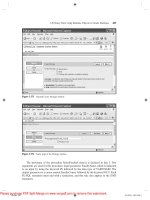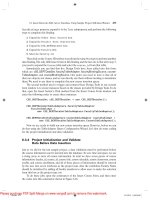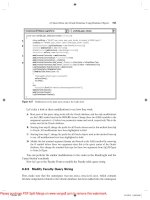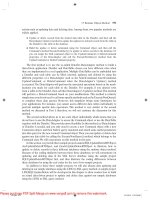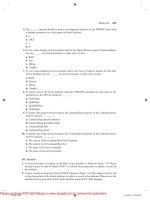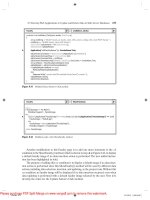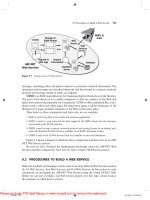Lecture Learning programming using Visual Basic Net – Chapter 11 Using VISUAL Basic NET to create web applications
Bạn đang xem bản rút gọn của tài liệu. Xem và tải ngay bản đầy đủ của tài liệu tại đây (96.73 KB, 27 trang )
CHAPTER ELEVEN
Using Visual Basic .NET to
Create Web Applications
11- 2
Introduction
• We will look at applications where various parts
of the application run on the client as well as
servers.
• Visual Basic .NET has a powerful set of Web
Application tools.
• This is made possible using Microsoft’s
ASP.NET technology.
• Different Web architectures are examined.
McGraw Hill/Irwin
©2002 by The McGraw-Hill Companies, Inc. All
rights reserved.
11- 3
Introduction (cont.)
• An application is divided into three primary
functions:
– Presentation (GUI).
– Processing business logic.
– Data management.
• We will look at data validation.
• We will examine processing databases in the
Web Application context.
McGraw Hill/Irwin
©2002 by The McGraw-Hill Companies, Inc. All
rights reserved.
11- 4
Introduction (cont.)
• The chapter is ended with a project that
demonstrates how two or more Web pages can
communicate with each other by sharing data.
McGraw Hill/Irwin
©2002 by The McGraw-Hill Companies, Inc. All
rights reserved.
11- 5
Objectives
• Explain the various functions of a typical Web
Application.
• Explain what is meant by “client/server.”
• Explain how the client/server architecture can be
implemented in a number of different ways.
• Discuss the trade-offs associated with various
client/server architecture options.
McGraw Hill/Irwin
©2002 by The McGraw-Hill Companies, Inc. All
rights reserved.
11- 6
Objectives (cont.)
• Build a Web Application using the tools available
with Visual Basic .NET.
• Validate user data using the Validation controls
supported by Visual Basic .NET.
• Use the Web Form DataGrid control to display a
data set and to edit and update a database.
• Use XSLT documents to transform XML into
HTML on the server to then be displayed on the
client.
McGraw Hill/Irwin
©2002 by The McGraw-Hill Companies, Inc. All
rights reserved.
11.1 An Introduction to Functional Web
Architectures
11- 7
• It is useful to break an application down into
three primary functions:
– Presentation involves how the application
interacts with the user.
– Business Logic involves rules that define how the
application handles data and processes them.
– Data Management involves databases and
software to management these databases.
McGraw Hill/Irwin
©2002 by The McGraw-Hill Companies, Inc. All
rights reserved.
11.1 An Introduction to Functional Web
Architectures (cont.)
11- 8
• Architecture refers to how these three functions
are allocated to various computers.
• Client refers to the computer (or other intelligent
device) that the user is using.
• Server refers to another computer that is distinct
from the client and may be located anywhere in
the world.
– One server is referred to as two-tier architecture.
– More than two servers are referred to as n-tier
architecture.
McGraw Hill/Irwin
©2002 by The McGraw-Hill Companies, Inc. All
rights reserved.
11.1 An Introduction to Functional Web
Architectures (cont.)
11- 9
• Presentation
– Option 1: Pure HTML.
• Any changes seen on the browser need to be sent
to the browser from the Web server.
• This option is unacceptable.
– Option 2: Script Within the Browser.
• Script are embedded within the HTML code sent
from the server to the browser.
• Creates very powerful user interfaces.
McGraw Hill/Irwin
©2002 by The McGraw-Hill Companies, Inc. All
rights reserved.
11.1 An Introduction to Functional Web
Architectures (cont.)
• Business Logic
– Option 1: All Client.
• The application runs exclusively on the client
computer.
• Low bandwidth requirement.
• For medium and large organizations, problems
involve software installation and maintenance.
• Limited use.
McGraw Hill/Irwin
©2002 by The McGraw-Hill Companies, Inc. All
rights reserved.
1110
11.1 An Introduction to Functional Web
Architectures (cont.)
– Option 2: Embed Business Logic in a Web Page
Using Client-Side Scripting.
• Uses scripts that are interpreted in the browser.
• Scripts process business logic.
• Overcomes the installation and maintenance
problems of Option 1.
• Problem with user ability to view the scripts.
McGraw Hill/Irwin
©2002 by The McGraw-Hill Companies, Inc. All
rights reserved.
1111
11.1 An Introduction to Functional Web
Architectures (cont.)
– Option 3: Embed a Client-Side Component in the
Web Page.
• A software component, not script, is embedded in
the Web page and downloaded.
• Shares the advantages of Option 2.
• Overcomes the problem of script visibility.
• Requires large bandwidth.
• Security is a major problem.
• Microsoft uses a trusted application model.
McGraw Hill/Irwin
©2002 by The McGraw-Hill Companies, Inc. All
rights reserved.
1112
11.1 An Introduction to Functional Web
Architectures (cont.)
1113
– Option 4: Process Business Logic on the Server.
• Business logic is processed on the server.
• Communication between a Web server and client
browser.
• Implemented using Active Server Pages (ASP).
• Includes all the advantages of Option 3 without the
disadvantages of potential large bandwidth and
trusted application issues.
McGraw Hill/Irwin
©2002 by The McGraw-Hill Companies, Inc. All
rights reserved.
11.1 An Introduction to Functional Web
Architectures (cont.)
1114
– Summary
• For business logic, a combination of Option 2 and
4 are most common.
• Option 2, client-side script, is used for data
validation and other nonproprietary processing.
• Option 4, server-side script, protects the privacy of
scripts.
• Option 4 is ideal for database support.
McGraw Hill/Irwin
©2002 by The McGraw-Hill Companies, Inc. All
rights reserved.
11.1 An Introduction to Functional Web
Architectures (cont.)
• Data Management
– Option 1: Client-Side Only.
• Database and database management system are
both on the client.
• Speed is the advantage.
• No network issues.
• No issues with multiple users.
• Problems with database consistency, installation,
and maintenance.
McGraw Hill/Irwin
©2002 by The McGraw-Hill Companies, Inc. All
rights reserved.
1115
11.1 An Introduction to Functional Web
Architectures (cont.)
– Option 2: Server-Side Only.
• Database and DBMS are both on the server.
• Problem with communicating requests to the
server.
McGraw Hill/Irwin
©2002 by The McGraw-Hill Companies, Inc. All
rights reserved.
1116
11.1 An Introduction to Functional Web
Architectures (cont.)
– Option 3: Send a Set of Records to Client for
Further Processing.
• Similar to Option 2.
• Data from the server is processed directly by the
browser.
McGraw Hill/Irwin
©2002 by The McGraw-Hill Companies, Inc. All
rights reserved.
1117
11.1 An Introduction to Functional Web
Architectures (cont.)
• Summary
– Many different options for processing
presentation, business logic, and data
management functions.
– The choice of options is critical to application
success.
McGraw Hill/Irwin
©2002 by The McGraw-Hill Companies, Inc. All
rights reserved.
1118
11.2 ASP.NET Web Applications
1119
• Creating a Simple Web Application
– Visual Basic .NET provides a template to create a
new Web Application project.
– Use ASP.NET Web Application instead of
Windows Application.
– The extension for the Web form is “.aspx”.
– Complete Example 11.1, Simple Web Application,
in your textbook.
McGraw Hill/Irwin
©2002 by The McGraw-Hill Companies, Inc. All
rights reserved.
11.2 ASP.NET Web Applications (cont.)
• Validating User Input
– Validator controls for Web Forms provide the
means for checking the contents of other
controls.
– Each input control can have zero or more
associated validators.
– Validators can perform on the client or server.
McGraw Hill/Irwin
©2002 by The McGraw-Hill Companies, Inc. All
rights reserved.
1120
11.2 ASP.NET Web Applications (cont.)
• Validation Controls for Web Forms
Type of Validation
Control to Use
Required entry
Comparison to a value
Range checking
Pattern matching
RequiredFieldValidator
CompareValidator
RangeValidator
RegularExpressionValidator
User-defined
CustomValidator
McGraw Hill/Irwin
©2002 by The McGraw-Hill Companies, Inc. All
rights reserved.
1121
11.2 ASP.NET Web Applications (cont.)
1122
– Complete Example 11.2, Validating User Input, in
your textbook.
McGraw Hill/Irwin
©2002 by The McGraw-Hill Companies, Inc. All
rights reserved.
11.3 Using Databases with Web
Applications
• Complete the examples listed below in your
textbook:
– Example 11.3 Using a DataGrid to Display Data
on a Web Form.
– Example 11.4 Editing Data Using a DataGrid
Component.
– Example 11.5 Using XML and XSL with Web
Form.
McGraw Hill/Irwin
©2002 by The McGraw-Hill Companies, Inc. All
rights reserved.
1123
Chapter Summary
1124
• The three primary functions of any application
are presentation, business logic, and data
management.
• With Web Applications, presentation is almost
always managed on the client using a browser.
• The processing of business logic can be
handled on the client or server.
• Processing simple business rules is best done
with embedded script on the client.
McGraw Hill/Irwin
©2002 by The McGraw-Hill Companies, Inc. All
rights reserved.
Chapter Summary (cont.)
1125
• Complex and/or proprietary business logic
typically should be done on the server.
• Data management is typically handled on a
server.
• Visual Basic .NET supports Web Application
projects.
• The Web Form is the primary component in Web
Application projects.
McGraw Hill/Irwin
©2002 by The McGraw-Hill Companies, Inc. All
rights reserved.



